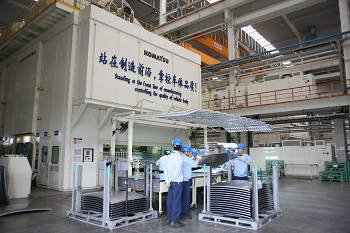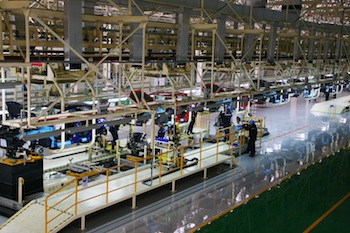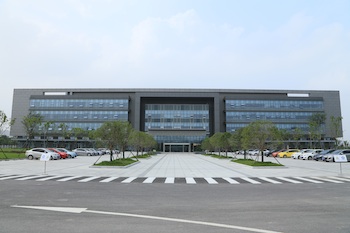Chang Tiejun, body area manager at Changan Mazda's Nanjing facility, discusses the challenges of keeping pace with demand, handling changing materials and vehicle architectures, and planning for the future
AMS: Do you have both blanking and stamping operations here at Nanjing?
Chang Tiejun (CT): We only have stamping operations at this location; the blanks are sourced from an outside supplier.
AMS: What stamped parts are made here?
CT: We produce 33 separate car parts for each of the models we produce here. These include the roof, doors (inner and outer sections), bonnet, tailgate and side frames.

CT: All the Mazda parts are for this plant, but we do supply some Fiesta stampings for Ford plants in Taiwan and Thailand.
AMS: How many stamping lines do you have at this plant?
CT: We have two high-speed lines. The A-line features a five-stage press while the B-line has a four-stage press. Both lines produce all of Mazda parts but eight of the Fiesta parts can only be completed on the A-line.
Our aim is to cut the number of stamping stages to improve efficiency and cut costs. We want to reduce the amount of tooling needed, but this is very challenging. This begins with the design of the vehicle, then with the design of the [production] process and tooling.
The die designs come from Mazda in Japan but the tooling is supplied by a Chinese manufacturer. The initial design, machining and trialling of the dies are all done in Japan. Once this has reached a certain point of development, then they come here for the final stage. We have a test press here for this purpose. Most of our presses come from a Chinese supplier, others are supplied by Komatsu, and we are using electric servo presses.
The lines are automated except for off-loading, which is done manually. The workers check each part as they remove them and this visual check is part of the quality-control process.
AMS: Now that you have established CX-5 production, are there any plans to build other models or platforms at Nanjing?
CT: We are working on a new project, a completely new vehicle, which should start production in 2017.
 Nanjing produces 33 separate car parts for each model, including the roof, doors, bonnet, tailgate and side frames
Nanjing produces 33 separate car parts for each model, including the roof, doors, bonnet, tailgate and side framesCT: In the bodyshop we have a single, main line that is very flexible and able to accommodate up to ten different models. The only additions would be to create additional sub-lines for any unique parts. With the SkyActiv technology, we had to invest in improved welding equipment for more complex spot welding requirements.
AMS: Do you have enough installed capacity here to add more models?
CT: When we start production of the new model in 2017 we might reduce production of an older model, but this will depend on the market demand.
AMS: Can you explain the quality-control processes in the press and bodyshops?
CT: We have two quality-control points in the press shop and three in the bodyshop. We use both visual and CMM [coordinate measuring machine] checks in the press shop. The visual checks are on 100% of the parts but the CMM is used to check on a batch basis. We operate very high levels of quality control, matching the standards of both Mazda and Ford.
AMS: What are the biggest challenges for the press shop operations?
CT: One challenge is to ensure the press shop has the flexibility to produce the parts for the growing range of different vehicles, with new body designs and architectures. Also, there is a demand to reduce the weight of the BIW [body-in-white] and this means being able to form different materials. So we must develop processes and tooling for producing parts out of the latest advanced and ultra-high strength steels, and also look to other materials such as aluminium.
Reducing costs and improving efficiency are very important, so we look at ways to reduce waste and increase productivity. This is an ongoing process. The market changes quickly and there is a real need to reduce the time-to-market of new models, so we are trying to reduce the time it takes to develop the tooling for the stamped parts. There is now much closer co-operation between the design and manufacturing engineering teams to speed up the process of development.
 The TCF operates a synchronised logistics and distribution system that can deliver precise instructions to each workstation
The TCF operates a synchronised logistics and distribution system that can deliver precise instructions to each workstationThe two high-speed stamping lines are capable of 12-15spm feed parts for the bodyshop. Flexibility is key and the need for short runs has increased. Automatic die changeover takes three minutes and the presses are able to produce six to eight parts at the same time.
The highly automated bodyshop has a single flex line capable of producing ten different models and features 138 robots in 34 stations using a numerical location system. There is also a laser-welding cell for attaching the vehicle roofs.
Using 46 ABB robots to apply 20 different colours, the paintshop has an environmentally friendly, middle-coat free, water-based paint system which is claimed to reduce CO2 emissions by 14% and VOCs by 78%.
The trim, chassis and final shop (TCF) operates a synchronised logistics and distribution system that can deliver precise instructions to each workstation in the TCF. As part of the quality control process, a torque monitoring system covers over 88 processes in real-time to prevent any faults forward in the production process.
 The Nanjing technology development centre features five whole-vehicle and three system-level test laboratories
The Nanjing technology development centre features five whole-vehicle and three system-level test laboratoriesThis is Mazda’s only R&D centre outside Japan and currently develops adaptions for the Chinese market; but the test labs, design and prototyping facilities will have an expanded role in the future, working on new vehicle launches, model upgrades and development cost reductions.
• Established 2007
• Site covers 129 hectares
• Total investment: 5.4 billion yuan ($869.7m)
• 16 departments employing more than 3,500 staff
• Annual production capacity: 220,000 units
• Models produced: Mazda2, Mazda3, Mazda 3 Axela, CX-5
• Production operations: stamping, body, paint, TCF


































